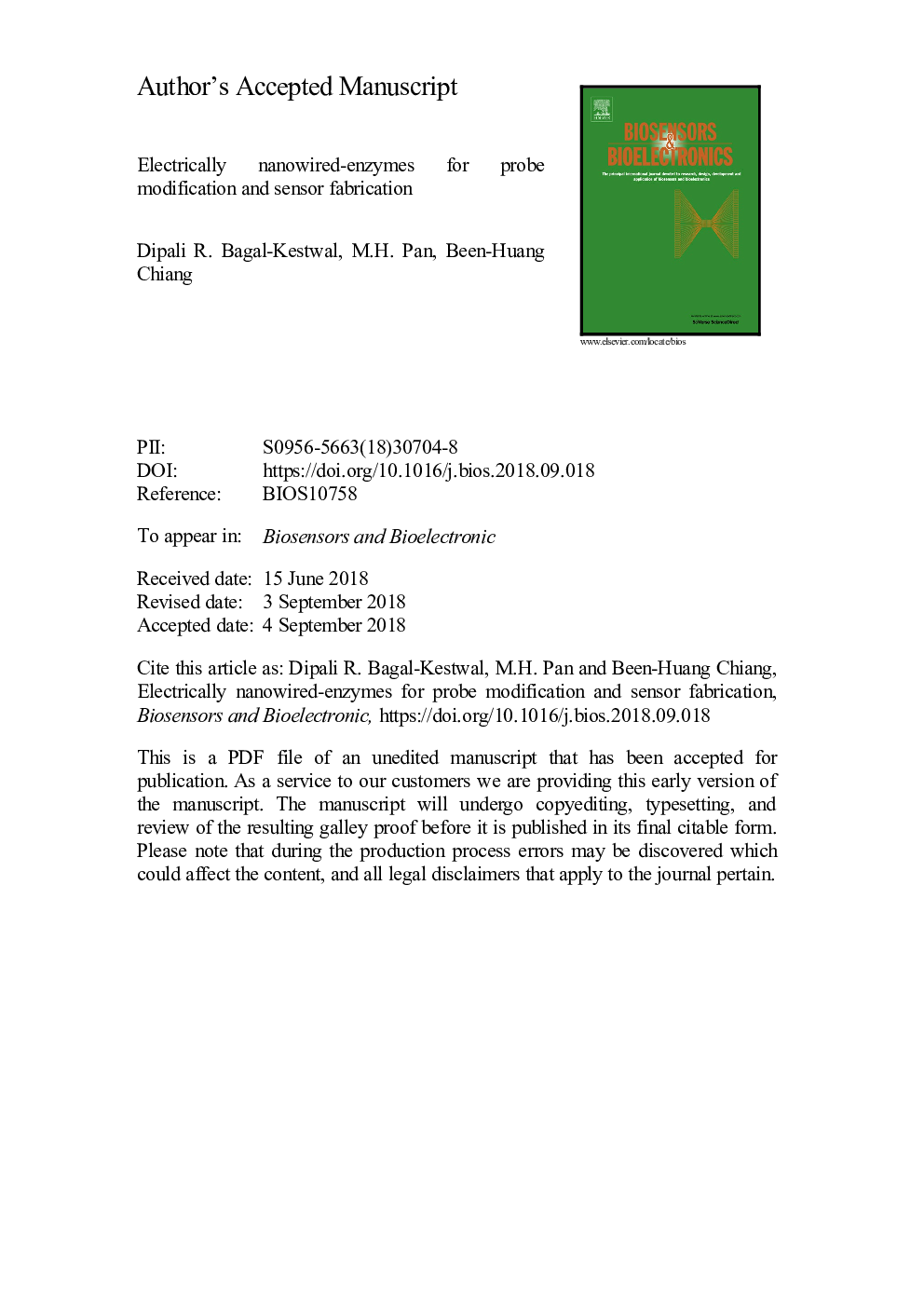| کد مقاله | کد نشریه | سال انتشار | مقاله انگلیسی | نسخه تمام متن |
|---|---|---|---|---|
| 10146969 | 1646421 | 2018 | 42 صفحه PDF | دانلود رایگان |
عنوان انگلیسی مقاله ISI
Electrically nanowired-enzymes for probe modification and sensor fabrication
ترجمه فارسی عنوان
آنزیم های نانوسیم الکتریکی برای اصلاح پروب و تولید سنسور
دانلود مقاله + سفارش ترجمه
دانلود مقاله ISI انگلیسی
رایگان برای ایرانیان
کلمات کلیدی
ترجمه چکیده
آنزیم ها به دلیل ساختار کاتالیزوری سه بعدی دقیق و پیچیده بسیار خاص و انتخابی هستند. انتقال الکترون در آنزیم ها به طور معمول از طریق مراکز فعال فلز یا تونل زنی رخ می دهد که به واسطه ساختار پروتئینی کروی در اطراف آن بسیار عایق هستند. در مورد آنزیم / پروتئین فعال الکتروشیمیایی، فاصله بین کافاکور فعال مجدد و سطح الکترود نقش کلیدی در ارتباط مستقیم دارد. بنابراین، فاصله طولانی تونل الکترونی را می توان با معرفی واسطه های مجدد مجدد تلفن همراه مانند نانوساختارها به ویژه نانوسیم ها که می توانند در محل فعال آنزیم انتشار پیدا کنند و یا معادل آن را کاهش دهند یا اکسیداسیون کنند. بنابراین، آنزیم های کنجو نانوسیم علاقه زیادی به توسعه دستگاه های بیوسنسور و سایر کاربردهای الکتروکاتالیستی-بیولوژیکی به دست آورده اند. در اینجا ما یک بررسی جامع در مورد سنسور مبتنی بر آنزیم الکتروشیمیایی با استفاده از نانوسیم ها ارائه می دهیم. در طول دهه گذشته، نانوسیم ها به عنوان یک مساحت نسبتا بالا و نسبت بالای سطح به حجم به عنوان یک پلت فرم چند منظوره برای کاربردهای مختلف از جمله سنسورها و سنسورهای بی حس کننده مورد بررسی قرار گرفتند. این بررسی با هدف خلاصه کردن برخی از تحولات اخیر در تحقیقات سنسور مبتنی بر آنزیم انجام شده است که با ساختارهای نانوساختار یک بعدی، یعنی نانوسیمهای فلزی و غیر فلزی، به دست آمده است. با توجه به کم و یا بدون سمیت و سازگاری زیستی، آنزیم های متصل با نانوسیم هنوز بسیار خاص، حساس و بیولوژیکی فعال هستند. این بررسی نشان می دهد قابلیت استفاده بالقوه از آنزیم های نانوسیم برای برنامه های کاربردی زیست محیطی. این بررسی شامل انواع مختلفی از نانوسیم ها، روش متداول ادغام آنزیم یا روش های بی حرکتی، اصلاح پروب، تولید بیوسنسور و آزمایش نمونه های واقعی یا اسپیک می باشد. پارامترهای بیوسنسور مانند محدوده خطی و حساسیت، انتخابی و محدودیت تشخیص سنسورهای گزارش شده نیز مورد توجه قرار گرفته است. ما همچنین برخی از مواد جدید نانوسیم را معرفی می کنیم که هنوز برای بیوسنزینگ یا استفاده از حسگر بیوسنسور استفاده نشده است. محدودیت ها، چالش ها و چشم انداز های استفاده از آنزیم های نانوسیم در سیستم های سنجش الکتریکی و سایر زمان سنج های الکتروشیمیایی و نیز فن آوری های تولید در این بررسی نیز مورد بحث قرار گرفته است.
موضوعات مرتبط
مهندسی و علوم پایه
شیمی
شیمی آنالیزی یا شیمی تجزیه
چکیده انگلیسی
Enzymes are highly specific and selective due to their precise, intricate three-dimensional catalytic- structure. Electron transfer in enzymes normally occurs through an active-metal centers or tunneling events that are highly insulated by the surrounding globular protein structure. In case of electrochemically active enzymes/proteins, the distance between the redox-active cofactor and the electrode surface plays key role during direct communication. Therefore, the long electron-tunneling distance can be overcome by introducing mobile redox mediators such as nanostructures specially nanowires which can diffuse into and out of the enzyme active site, ferrying reducing or oxidizing equivalents with them. Therefore, nanowire-conjugated enzymes have gained great interest in the development of biosensor devices and other electrocatalytic-biological applications. Herein we present a comprehensive review about the electrochemical enzyme-based sensor using nanowires. Over the past decade, nanowires were investigated as a versatile platform for various applications including sensors and biosensors because of their high aspect ratio and a high surface-to-volume ratio. This review aimed to summarize some of the recent developments in the enzyme based sensor research that have been achieved with various metallic and non-metallic one-dimensional nanostructure i.e. nanowires. Due to low or no toxicity and biocompatibility, enzymes conjugated with nanowires are still highly specific, sensitive and biologically active. This review demonstrates the potential usability of nanowired-enzymes for the bioanalytical applications. The review includes various types of nanowires, mode of the enzyme integration or immobilization methodologies, probe modification, biosensor fabrication and real or spiked sample testing. Biosensor parameters such as linear range and sensitivity, selectivity and detection limit of reported sensors were also considered herein. We also introduce some of the new nanowire materials which have not yet been used for biosensing or biosensor application. The limitations, challenges and prospects for the use of nanowired-enzymes in electrochemical and other real-time sensing systems as well as fabrication technologies are also discussed in this review.
ناشر
Database: Elsevier - ScienceDirect (ساینس دایرکت)
Journal: Biosensors and Bioelectronics - Volume 121, 15 December 2018, Pages 223-235
Journal: Biosensors and Bioelectronics - Volume 121, 15 December 2018, Pages 223-235
نویسندگان
Dipali R. Bagal-Kestwal, M.H. Pan, Been-Huang Chiang,
